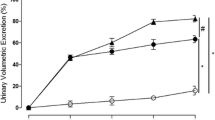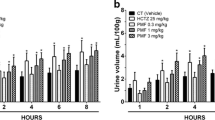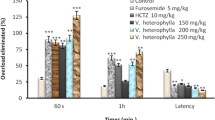The aim of this work was to evaluate diuretic activity of the ethanol extract of Euphorbia hirta leaves and elucidate the possible mechanism of its action. The diuretic activity was studied on male albino rats in comparison to furosemide as a standard drug. Two doses of E. hirta extract (300 and 600 mg/kg) were administered and the urinary volume and electrolyte (Na+, K+) concentrations were measured. Results showed that administration of the ethanol extract of E. hirta led to significantly increased urinary volume and excretion of urinary electrolytes such as sodium, potassium and chloride in 24 h urine compared to that for normal animals. Among the two selected doses, 600 mg/kg body weight exhibited higher diuretic activity level than 300 mg/kg dose. Although both these levels were statistically significant when compared to control in respect of all parameters, these levels were lower compared to the standard drug. Hence, the ethanol extract of E. hirta exhibited a dose dependent diuretic activity. Upon the isolation and identification of active compounds from E. hirta ethanol extract, it was found that lupeol and quercetin were the major constituents responsible for the diuretic activity in rats. The present study confirmed validity of the ethnopharmacological use of E. hirta as a diuretic agent under experimental conditions studied.


Similar content being viewed by others
References
E. M. Lind and A. C. Tallantire, Some Common Flowering Plants of Uganda, Oxford University Press: Nairobi (1971), p. 182.
M. C. Lanhers, J. Fleurentin, and P. Cabalion, J. Ethnopharmacol., 29, 189 – 198 (1990).
M. C. Lanhers, J. Fleurentin, P. Dorfman, et al., Planta Med., 57, 225 – 231 (1991).
W. L. Lipschitz, Z. Hadidian, and A. Kerpcsar, J. Pharmacol. Exp. Ther., 79, 97 – 110 (1943).
S. T. Kau, J. R. Keddi, and D. Andrews, J. Pharmacol. Methods, 11, 67 – 75 (1984).
P. B. Godkar and D. B. Godkar, Textbook of Medical Laboratory Technology (2nd edn.), Bhalani Publishing Home: Mumbai (2003), pp. 409 – 418.
O. Schales and S. S. Schales, J. Biol. Chem., 140, 879 – 883 (1941).
S. Asha, P. Thirunavukkarasu, and A. Mohamad Sadiq. World J. Pharm. Sci., 3(6), 1104 – 1112 (2015).
J. M. Watt and M. G. Breyer-Brandwijk, The Medicinal and Poisonous Plants of Southern and Eastern Africa. E. S. Livingstone Ltd., London (1962).
G. De Stevens, Diuretics: Chemistry and Pharmacology, Academic Press: New York (1963), pp. 52 – 58.
E. K. Jackson, Drugs affecting renal and cardiovascular function. Pergamon Press: New York (1996), pp. 685 – 713.
J. C. Milton, M. Shelton, and H. Brainerd, Hand book of medical treatment, Lange Medical Publication–Blackwell Scientific Publication: Oxford (1970), pp. 220 – 229.
P. B. Johnson, E. Abdurahman, A. T. Emmanuel, and I. M. Hussaini, J. Ethnopharmacol., 65(1), 63 – 9 (1999).
J. Diezi, Diurétiques, in: M. Schorderet, Pharmacologie, des Concepts Foundamentaux aux Applications Therapeutiques. Frison-Roche: Paris (1992), pp. 151 – 167.
F. G. Smith and A. M. Strack, Am. J. Physiol., 269, 149 – 152 (1995).
C. Presne, M. Monge, J. Mansour, et al., Nephrol. Ther., 3, 392 – 423 (2004).
J. R. Montejano-Rodriguez, G. Almaguer-Vargas, J. A. Gayosso-De Lucio, et al., J. Pharm. Res., 6, 709 – 713 (2013).
C. V. Pantoja, L. C. Chiang, B. C. Norris, et al., J. Ethnopharmacol., 31, 325 – 331 (1991).
L. H. Bevevino and M. M. Aires, J. Ethnopharmacol., 43, 203 – 207 (1994).
S. I. Kreydiyyeh and J. Usta, J. Ethnopharmacol., 79, 353 – 357 (2002).
B. D. Rose, Diuretics, in: Kidney Int., Vol. 39 (1991), pp. 336 – 352.
T. Shinkawa, F. Yamaski, T. Notsu, et al., Eur. J. Pharmacol., 238, 317 – 325 (1993).
E. K. Jackson, The Pharmacological Basis of Therapeutics, McGraw- Hill: New York (2001), pp. 775 – 788.
J. Leuschner, Arzneim. Forsch., 45, 165 – 168 (1995).
W. D. Ratnasooriya, K. P. Pieris, U. Samaratunga, and J. R. Jayakody, J. Ethnopharmacol., 91, 317 – 20 (2004)
H. P. Rang, M. M. Dale, J. M. Ritter, and P. K. Moore, Pharmacology (5th edn.), Churchill Livingstone: Edinburgh–New York (2003), pp. 352 – 366.
A. Cáceres, L. M. Girón, and A. M. Martínez, J. Ethnopharmacol., 19(3), 233 – 245 (1987).
F. B. O. Mojiminiyi et al, J. Med. Med. Sci., 2, 77 – 80 (2000).
O. M. Arafat, S. Y. Tham, A. Sadikun, I. Zhari, et al., J. Ethnopharmacol., 118, 354 – 360 (2008)
A. Herrera-Arellano, S. Flores-Romero, M. A. Chavez-Soto, and J. Tortoriello, Phytomedicine, 11, 375 – 382 (2004).
C. Sadki, B. Hacht, A. Souliman, and F. Atmani, J. Ethnopharmacol., 128, 352 – 356 (2010).
CONFLICT OF INTEREST
The authors declare that they have no conflicts of interest.
Author information
Authors and Affiliations
Corresponding author
Rights and permissions
Springer Nature or its licensor (e.g. a society or other partner) holds exclusive rights to this article under a publishing agreement with the author(s) or other rightsholder(s); author self-archiving of the accepted manuscript version of this article is solely governed by the terms of such publishing agreement and applicable law.
About this article
Cite this article
Asha, S., Thirunavukkarasu, P., Taju, G. et al. Effect of Euphorbia hirta on Urinary Flow in Albino Male Rats. Pharm Chem J 56, 1087–1091 (2022). https://doi.org/10.1007/s11094-022-02758-0
Received:
Published:
Issue Date:
DOI: https://doi.org/10.1007/s11094-022-02758-0




